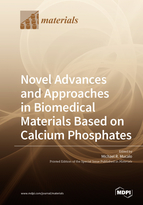Novel Advances and Approaches in Biomedical Materials Based on Calcium Phosphates
A special issue of Materials (ISSN 1996-1944).
Deadline for manuscript submissions: closed (31 August 2018) | Viewed by 54565
Special Issue Editor
Interests: biomedical materials; calcium phosphate chemistry; metal colloids; IR spectroelectrochemistry; repurposing of byproducts/waste; application of IR spectroscopy, solid state NMR; drug delivery
Special Issues, Collections and Topics in MDPI journals
Special Issue Information
Dear Colleagues,
Research into the use of calcium phosphates in the development and clinical application of biomedical materials has been a significantly diverse activity by a wide range of scientists, engineers and medical practitioners, among others. The field of research in this area can hence be truly defined as interdisciplinary and much interesting work leading to imaginative and innovative solutions for the improvement of health outcomes continues.
It is the intention of this Special Issue to summarize a wide selection of the current advances in this area. We thus invite contributions to this issue in the form of original articles, review articles, research notes and short communications from various areas of this scientific discipline. Areas of interest that could be covered are contributions based on uses of natural by products to form potential biomaterials, novel composites of calcium phosphates with other materials, chemical manipulations of calcium phosphates that lead to novel biomaterials, studies advancing further the cell biology surrounding the incorporation of calcium phosphate biomaterials, engineering/biomechanical aspects of using calcium phosphate biomaterials and human or animal clinical studies involving calcium phosphates. Studies on novel approaches to characterization to study these materials would also be of interest. Other types of contribution welcomed would be from those involved with regulating the use of calcium phosphate biomaterials. Hence, we invite, scientists, engineers, doctors, and medical device regulators to submit articles of interest.
It is hoped that this Special Issue will be enriched with these very diverse topics that provide an overall picture of advancements in this area.
We look forward to your contributions. Each article will be subject to rigorous peer review.
Associate Professor Michael R. Mucalo
Guest EditorManuscript Submission Information
Manuscripts should be submitted online at www.mdpi.com by registering and logging in to this website. Once you are registered, click here to go to the submission form. Manuscripts can be submitted until the deadline. All submissions that pass pre-check are peer-reviewed. Accepted papers will be published continuously in the journal (as soon as accepted) and will be listed together on the special issue website. Research articles, review articles as well as short communications are invited. For planned papers, a title and short abstract (about 100 words) can be sent to the Editorial Office for announcement on this website.
Submitted manuscripts should not have been published previously, nor be under consideration for publication elsewhere (except conference proceedings papers). All manuscripts are thoroughly refereed through a single-blind peer-review process. A guide for authors and other relevant information for submission of manuscripts is available on the Instructions for Authors page. Materials is an international peer-reviewed open access semimonthly journal published by MDPI.
Please visit the Instructions for Authors page before submitting a manuscript. The Article Processing Charge (APC) for publication in this open access journal is 2600 CHF (Swiss Francs). Submitted papers should be well formatted and use good English. Authors may use MDPI's English editing service prior to publication or during author revisions.
Keywords
- calcium phosphate
- hydroxyapatite
- characterisation
- regulation
- natural matrices
- clinical use
- orthopedics
- xenografts
- medical devices







